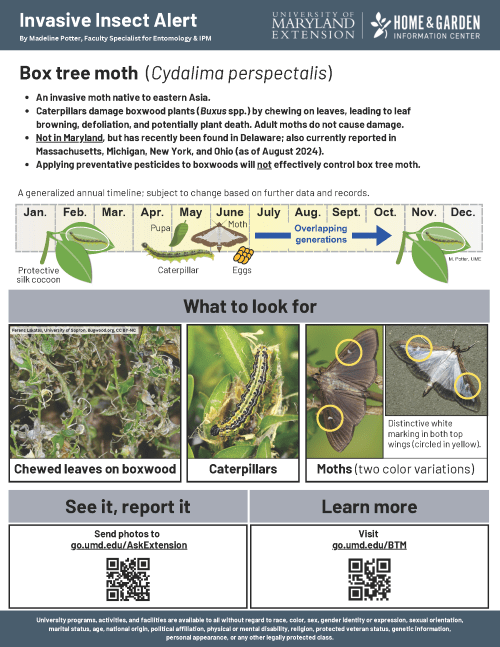
Box tree moth (Cydalima perspectalis) is a new invasive pest in the United States (not yet in Maryland as of August 2024).
A New Pest of Boxwoods: See It, Report It
This invasive insect has not been reported in Maryland, but it has been found recently in Kent County, Delaware (July 2024), Erie, Pennsylvania (September 2024), and several other US states. If you believe you have seen this insect or its damage, send reports and photos to Ask Extension. Help spread the word by sharing the downloadable box tree moth alert below.
Key points
- Box tree moth (Cydalima perspectalis) is an invasive insect (moth) native to eastern Asia. This moth was first detected in North America (in Toronto, Canada) in 2018. Though not currently present in Maryland (as of October 2024), box tree moth is a potential new threat to boxwoods. USDA/APHIS has confirmed that box tree moth has been found in Delaware, Massachusetts, Michigan, New York, and Ohio. In September 2024, the Pennsylvania Department of Agriculture confirmed that it was found at two locations in Erie, Pennsylvania.
- Box tree moth caterpillars damage boxwood plants by chewing boxwood leaves and bark, leading to leaf browning, defoliation, and girdling.
- If you see chewing damage on boxwood leaves, it may be caused by box tree moth.
- In the United States, box tree moth caterpillars have only been found feeding on boxwoods (Buxus spp.) so far.
- Applying preventative pesticides to boxwoods will not effectively control box tree moth. Unnecessary pesticide applications can negatively impact beneficial insects and can even cause secondary pest outbreaks.
- Monitor your boxwoods regularly (April through October) and look for the below signs and symptoms of box tree moth.
- Be aware of up-to-date federal quarantines for box tree moth. These quarantines help to prevent the further spread of box tree moth through the movement of infested plant material. See this Box Tree Moth Federal Quarantine Boundary Viewer.
Identification
Eggs
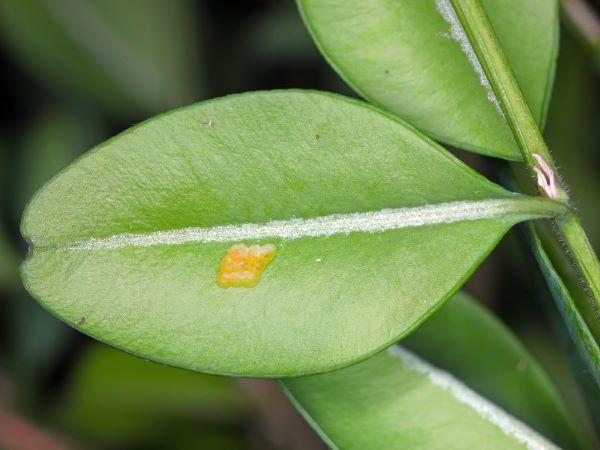
Eggs: Pale yellow, flat-like, overlap, and usually laid in clusters of 5-20 eggs. Each egg is approximately one millimeter in diameter. The eggs are typically laid on the underside of boxwood leaves.
Larvae (caterpillars)
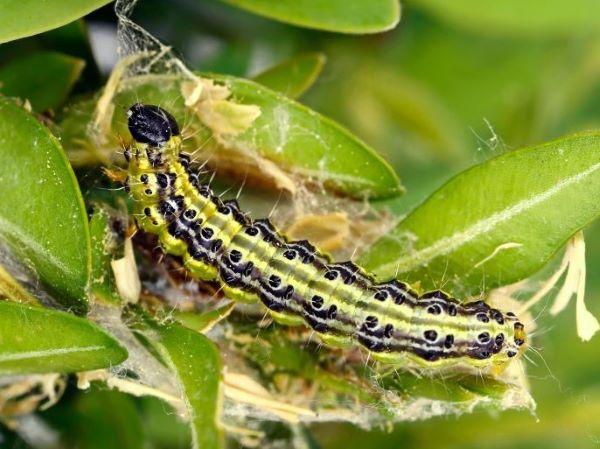
Larvae (caterpillars): A black head capsule with a green and yellow body patterned with white, yellow, and black stripes and black spots. The caterpillars like to hide within protective structures made out of silk webbing and leaves, making them difficult to spot at times. Their size varies since they grow larger through each instar (life stage between molts).
Pupae
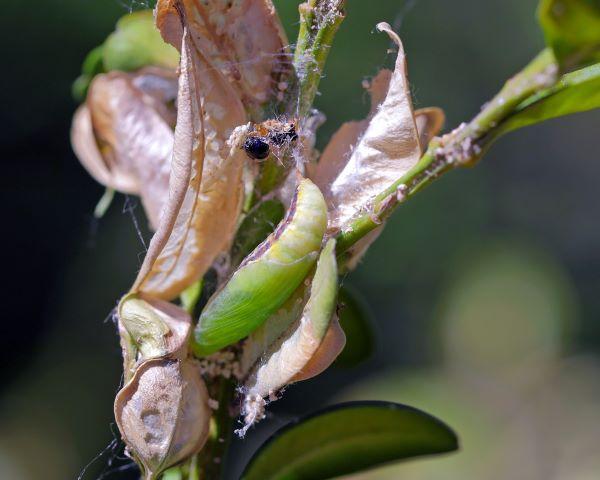
Pupae: Young pupae are green with brown stripes. Mature pupae become more translucent and you can begin to see the adult moth wing patterns. Pupae are around 20mm (0.8 inches) long and are typically found within damaged boxwood leaves and webbing/silk.
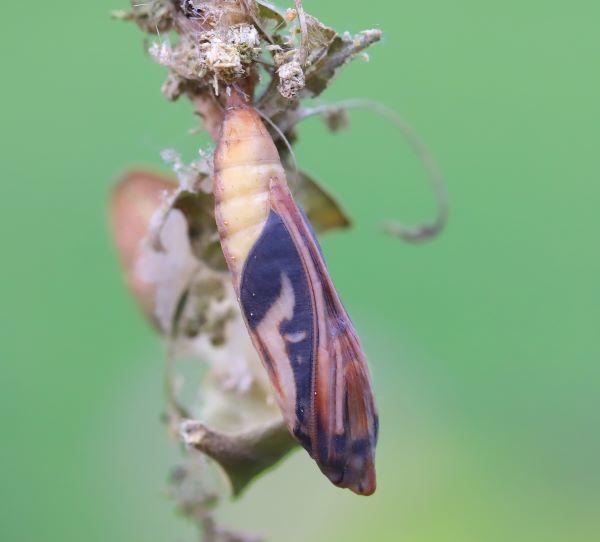
Adult moths

Adult moths: There are two different color variants. One variant has a white body and white wings with bronze-brown wing margins and a small white marking on both top wings. The second color variant has a brown body with brown wings with a small white marking on either top wing. Box tree moth wingspans range from 40-45 mm (~1.5 inches). Adult moths are nocturnal (active at night).
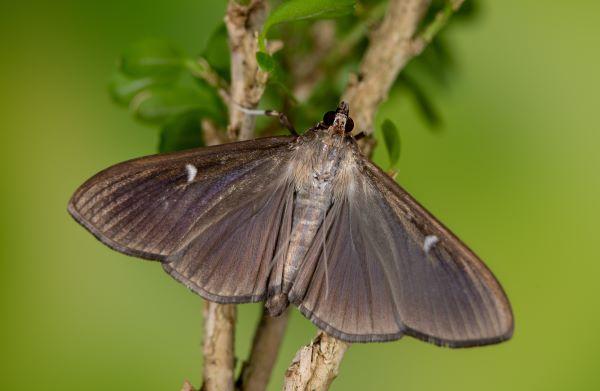
Damage
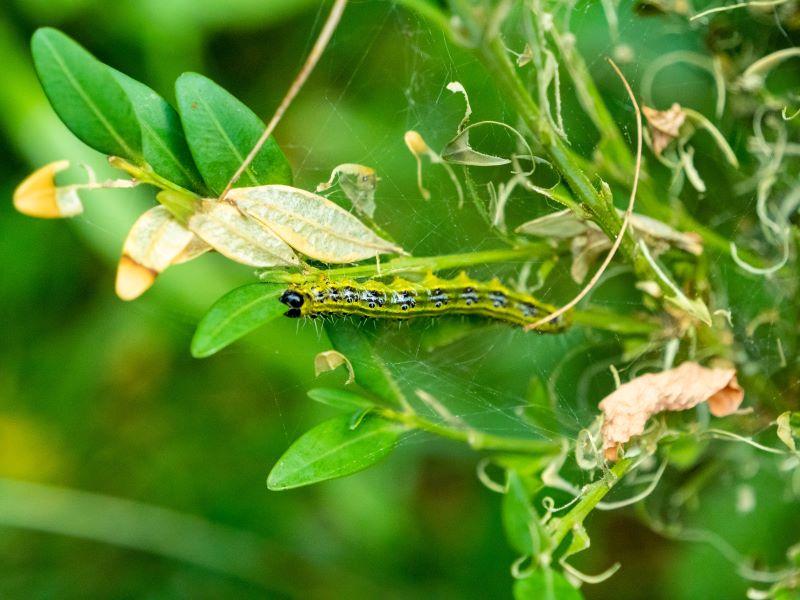
Chewing damage: Injury begins with young caterpillars that chew on the undersides of leaves, removing one layer of leaf tissue. Older caterpillars can defoliate leaves either by consuming the entire leaf or by just leaving behind the leaf edges and/or leaf midvein (creating a "curlicue" leaf appearance). Extensive feeding can result in "see-through" brown boxwoods and potentially plant death. Box tree moth caterpillars have also been observed chewing boxwood bark, leading to girdling (a circular groove around a woody stem that cuts off the movement of nutrients) and potentially plant death.
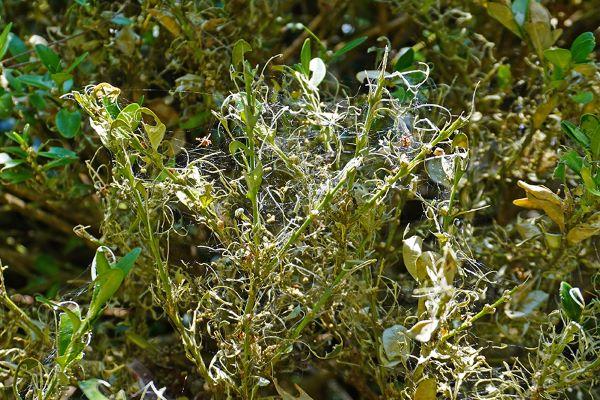
Silk and Frass
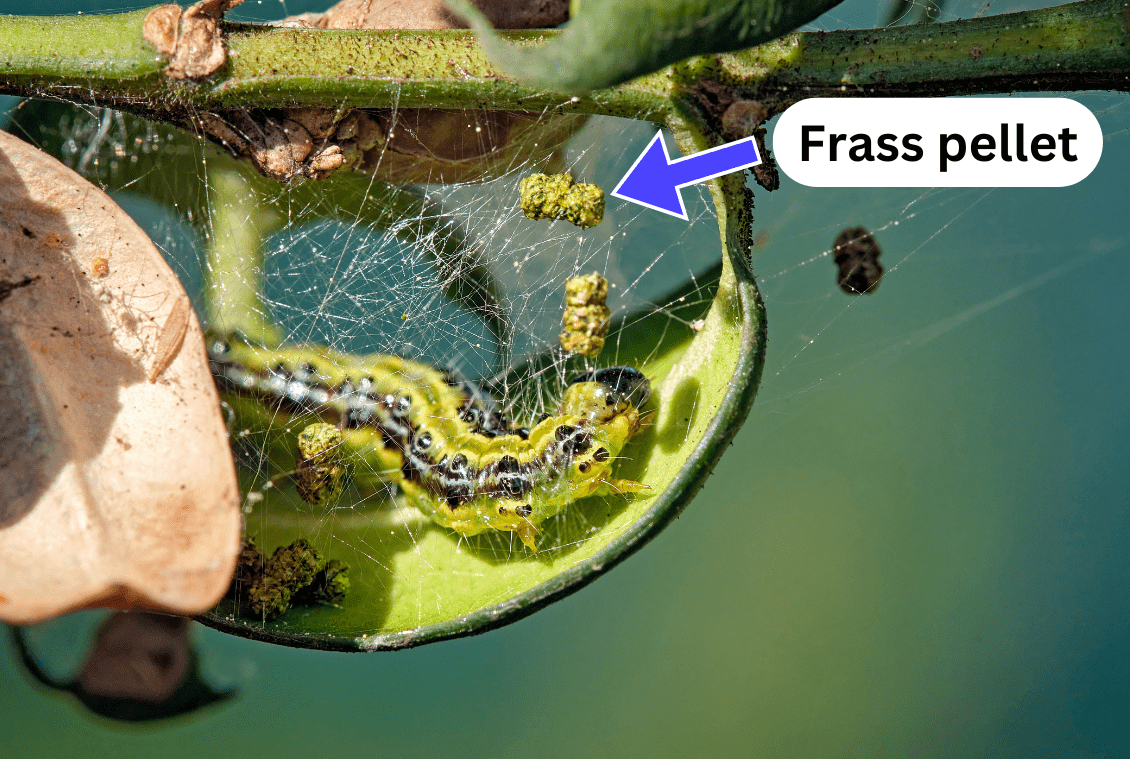
Silk and frass: Caterpillars produce wispy silk webbing, sometimes used to connect leaves and branches together to create protective structures. Small light green-brown frass pellets (excrement) can be found within silk or on the ground underneath infested plants.
Overwintering structures (hibernacula)

Overwintering structures (hibernacula): Hibernacula (sing. hibernaculum) are structures created by caterpillars for protection during the cold winter months. The structure is usually created out of a silken pouch attached to one or more leaves.

Annual timeline

Caterpillars emerge from their leaf and silk overwintering structures around April, developing over a span of ~28 days, through a pupal stage, to reach their adult moth form. Adult moths will lay eggs and a course of multiple overlapping generations will take place between May and October. Around October, caterpillars will create their overwintering structures and remain there until the following spring. This is a generalized annual timeline and is subject to change based on further data and records. Figure created by Madeline Potter, UME.
Lifecycle
- Box tree moth can have several overlapping generations; the number of generations and length of the different developmental stages varies by location and weather conditions. So far box tree moth has been observed to have between two to five overlapping generations per year.
- Around April caterpillars emerge from their overwinter structures, called hibernaculum (created out of silk and leaves attached to a boxwood). The caterpillar will begin feeding and grow through as many as seven instars (life stages between molts), over a span of approximately 14 days, before reaching their pupal stage.
- Mature caterpillars will form a pupa, attached to a boxwood plant, to finish their development. The pupal stage lasts approximately 14 days.
- Adult moths emerge from their pupa to seek mates and lay eggs. They have a lifespan of about 14 days.
- Eggs develop and hatch in approximately three days.
- Between May and October box tree moth will produce several overlapping generations.
- Around October caterpillars will create their overwintering structures where they will remain, in diapause (dormancy/suspended development), through the cold winter months until the following spring.
Management
- Confirm the identification of box tree moth by submitting photos through Ask Extension before applying controls. Unnecessary treatments can harm beneficial insects and cause secondary pest outbreaks. Do not apply preventative insecticide applications.
- With small infestations, hand-pick or prune caterpillars off plants and place them in a bucket of soapy water.
- For large infestations, use a horticultural oil or insecticidal soap spray on small caterpillars, following all label instructions. Please note: adequate coverage is needed for effective control, aiming for the underside of leaves (where the young caterpillars feed). A professional pest control company can be contacted for further guidance.
- Heavily infested plants may need to be removed and destroyed to prevent further spread.
- Further management options are currently being researched.
Reducing the spread of box tree moth
- Box tree moth is spread through the movement of infested boxwood nursery stock and adult moth flight. One study in Europe suggested adult moths can sustain flights of over 20 miles. Be sure to check for signs of box tree moth on any boxwoods you purchase and on any existing boxwoods in your landscape. If you believe you have seen box tree moth or its damage, send reports and photos to Ask Extension.
- Within current box tree moth quarantined areas (see Box Tree Moth Federal Quarantine Boundary Viewer), boxwood (Buxus spp.) plants may only be moved interstate from an establishment operating under a compliance agreement (PDF) and a certificate issued by a State Agricultural Authority (see May 2024 Federal Order (PDF)). There are currently no box tree moth quarantine areas within Maryland.
Additional resources
- Box Tree Moth (Cydalima perspectalis) | Cornell University
- What to Look for with Box Tree (Boxwood) Moth | Ohio State University
- Box Tree Moth | Penn State University
- Box Tree Moth in the United States | Virginia State University
- Box Tree Moth Demystified | Horticultural Research Institute, Joe Boggs with Ohio State University and Alejandro Del-Pozo with Virginia Tech
- (PDF) Pest Alert: Box Tree Moth (Cydalima perspectalis) | USDA APHIS
Author: Madeline Potter, Faculty Specialist, Entomology & Integrated Pest Management (IPM), University of Maryland Extension, August 2024. Unless otherwise noted, all images are from Adobe Stock.
Still have a question? Contact us at Ask Extension.
